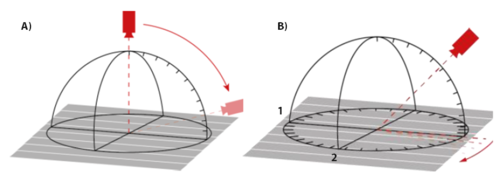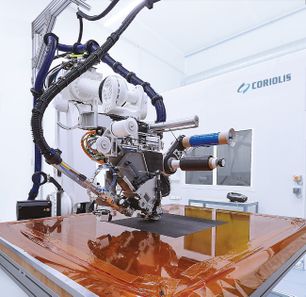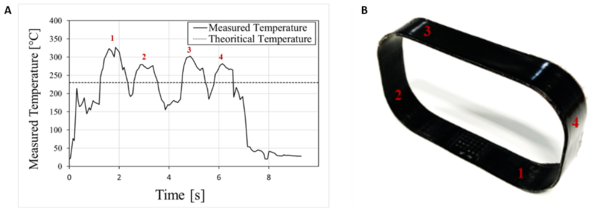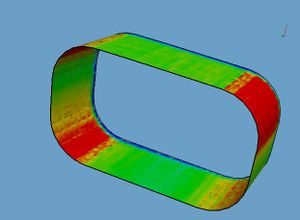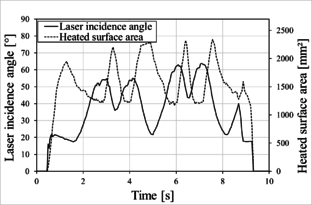ABSTRACT:
Automated fiber placement (AFP) is a highly efficient process to produce thermoplastic matrix composite parts. This process involves heating, compaction and cooling steps that must be understood and controlled to achieve an optimal process for the manufacture of structural parts. Heating using a laser provides many advantages due to high energy density and efficient control that are beneficial for process control and productibility [1]. However, the temperature distribution during the layup can be altered by process parameters, i.e., laser power, layup speed and compaction force [2, 3]. The geometric configurations of the laser and the temperature measurement device (IR camera) also need to be considered to control the heat flux distribution at the tape/substrate interface (nip point region) and temperature homogeneity of the part. At the composite scale, the consolidation quality is determined by governing mechanisms such as intimate contact development between plies, void consolidation, and adhesion, which are a function of temperature, time and pressure distribution [4].
Keywords: Automated fiber placement; Heating control; Thermoplastic composites; Heat homogeneity
La colocación automatizada de fibras (AFP) es un proceso muy eficiente para producir piezas en material compuestos con matriz termoplástica. Este proceso implica pasos de calentamiento, compactación y enfriamiento que de ser entendido y controlado para lograr un proceso óptimo para la fabricación de piezas estructurales. El calentamiento mediante láser permite muchas ventajas debido a la alta densidad de energía y al control eficiente que son beneficiosos para el control del proceso y la productividad [1]. Sin embargo, la distribución de la temperatura durante el laminado puede ser alterada por los parámetros del proceso, la potencia del láser, la velocidad de laminado y la fuerza de compactación [2, 3]. También es necesario considerar las configuraciones geométricas del láser y el dispositivo de medición de temperatura (cámara IR) para controlar la distribución del flujo de calor en la interfaz cinta/sustrato (región del punto de contacto) y la homogeneidad de la temperatura de la pieza. A escala de material compuesto, la calidad de la consolidación está determinada por mecanismos como el desarrollo del contacto íntimo entre capas, la consolidación del vacío y la adhesión que son función de la temperatura, del tiempo y de la distribución de la presión [4].
Palabras clave: Colocación automatizada de fibras; Control de calefacción; Materiales Compuestos termoplásticos;
1. Introduction
In the recent aircraft programs, the use of composite materials has reached new levels. The flag ships of both main aircraft manufacturers (Airbus A350 and Boeing B787) contain more than 50% by weight of composite structures. This is due to the fact that Carbon Fiber Reinforced Plastics (CFRP) offers better strength to weigh ratio than metals. Lighter aircraft structures allow for significant fuel saving (up to 25%) versus its aluminium competitors. [5-6]
A key enabler of the constant increase of composite materials (CFRP in particular) is the development of the automation of the manufacturing process like Automated Fiber Placement (AFP). These technologies allow larger and larger parts to be manufactured, which would not have been possible with manual manufacturing processes.
With their high molecular weight, thermoplastic resins have the ability to be re-melted and re-formed as they do not form a rigid three-dimensional cross-linked chemical structure after processing. On the one hand, when compared to thermoset matrix composites, ThermoPlastic (TP) composites show higher performance (Improved toughness and impact resistance, higher chemical resistance, low water absorption) and better manufacturability (Unlimited shelf life, wide range of manufacturing options, ability to be reformed, joining technics by welding and short processing time). On the other hand, processing TP is a challenge due to high melting temperature of the matrices, high processing pressures due to their high viscosity - high molecular weight, high and also repair procedures that are not mature. TP raw material cost also poses an economic problem limiting wider use [7].
Various studies have shown that the performance of composites produced by AFP process strongly depends on the local temperature history at the nip point [2, 3]. The temperature at the nip point is recognised as being a key point. This point is either used as a controlling parameter (closed loop control systems or is check by the monitoring system of the machine when the laser power is controlled using an opened loop control system. In either case, the temperature is measured using a vision system-based IR cameras.
Hence, many models have been developed to calculate the heat flux distribution in the substrate and incoming tape through a statistical, analytical, and numerical 2D or 3D approach [8, 9, 10]. These studies shows that laser incident angle, speed, heated zone, time of heating (in general heat flux distribution) have a strong effect on the heat flux therefore on the local temperature history at the nip point. Two aspects are considered in this paper:
In the first part of this paper, the quality of the temperature measurement using IR cameras is assessed. Several experiments were carried out from two viewpoints i.e. technological and physical. After considering the limits of the use of the IR camera for high temperature measurement, a specific experimental setup was created to measure the influence of the IR camera incident angle on the measured temperature as well as the substrate orientation. This test enables a direct evaluation of the temperature deviation caused by the incidence angle, independent of the camera’s technology. The angular modification from 90° to 0° led to a non-monotonic evolution of the temperature with a specific law depending on substate fiber orientation.
In a second part of this paper, the use of an optical model (rays tracing technique) using geometrical analysis, was developed. This allows to simulate optical configurations during the layup simulations, that are performed with a virtualization of the numerical control of the robot, with precise TCP speed instructions. This digital tool prevents heating issues by predicting shadow areas and non-homogeneous heating to correctly identify critical zones using a colour-map of heating/power distribution and therefore to optimize the program for part production (including modifications such as power/speed law).
2. Materials and Methods
2.1. Materials:
Commercially available carbon fiber reinforced PEKK tape (Hexcel) slitted in ½” width was used for AFP layup trials.
2.2. Experimental trials:
On-line monitoring of the temperature at the nip point is performed with compact IR cameras mounted on the lay-up arm. The minimal space available in the process configuration imposes to observe the thermal scene at a low angle of incidence causing inevitably altered estimation of the temperature. Indeed, during the recording, the surface emissivity is kept constant during the lay-up although it is known to depend on the incidence angle between the camera and the surface α as well as the fiber orientation of the substrate β.
A specific apparatus was designed to evaluate experimentally the effect of the incidence angle and of the fiber orientation on the composite tape surface temperature recorded by an infrared camera.
The apparatus consists of a heating sample holder design to heat composite tapes up to 300 °C. The system is equipped with various cartridges and the temperature is monitored with thermocouples close to the surface.
The bench is mounted on a pivotable arm which can be tilted independently in two directions. The two axes of rotation of the bench reproduce the observation angles of the AFP process:
- Incidence angle α between the substrate and the camera (Fig. 1.a)
- Fiber orientation β (Fig. 1.b)
2.3. AFP machine:
An industrial Automated Fiber Placement Csolo machine combined to an external rotative axis (maximum supported weight = 500 Kg; maximum speed = 50 rpm) by Coriolis Composites was used for this work (Fig. 2).
The machine was programmed to layup ½” continuous tape at a constant speed of 50 mm/s. The heat source for the process is a Laserline GmbH LDF 6000–100 6 kW fiber-coupled diode laser. The laser is installed remotely from the fiber placement head. The beam is guided through an optical fiber to a homogenizer optical unit to deliver a spot size of 40x15 mm. The laser power was set respecting a specific heating law which depends on the layup speed to keep the nip point temperature at 230 ± 20 °C. A compaction force of 200 N was applied by a deformable roller. Other machine configuration parameters which affect the temperature distribution in the process were adjusted: head tilt and air pressure of roller cooling system. These were all kept constant for the purpose of this work.
The layup tests were performed on a prototype layup tool supplied by ContiTech (France) having a rectangular cross section connected with radii of 20 mm.
2.4. Temperature measurement:
The material surface temperature at the nip point region (contact point between incoming fiber reinforced thermoplastic tape and substrate) was measured using an Optris thermal camera to follow the evolution of temperature during the entire ply layup.
2.5. Simulation software:
The simulation software SimuReal and its heat mapping numerical function enables the estimation of heat homogeneity of any AFP part. It calculates the energy distribution through geometrical criterion to simulate the laser irradiation zone. The optical model is based on ray intersection techniques and verification of energy distributions in order to assist AFP programmer to better define the heating laws (Laser power / Layup speed), to identify overexposed areas and improve the homogeneity of heating
3. Results
3.1. 1) IR camera characterization
Measurements were made at a tool temperature of T0 = 100 °C and T0 = 300 °C and for fiber orientations of β = 0°, 45° and 90°.
The evolution of the relative temperature (Tsurf(α )- Tsur (α = 0° )) according to α is shown in Fig. 3.
Different behaviours are observed according to the fibre orientation β. For β = 90°, measured temperature keeps decreasing exponentially with increasing incidence angle α. At α = 75°, the surface temperature is underestimated by 12 °C. Unlike this behaviour, for β = 0°, measured temperature slightly increases from α = 30° to α = 60° before decreasing exponentially This effect could be explained by the topology of the composite tape. A higher fraction of the emitted radiation may reach the camera sensor, causing a slight increase in the surface emissivity, for β = 0° more than for β = 90°, since fewer obstacles are present on its optical path. This phenomenon balances out the effect of low incidence angle and results in a measurement error equal to zero at α = 75°. For β = 45°, an intermediate behaviour is observed, and measured temperature starts decreasing exponentially around α = 50°. The measurement error at α = 75° equals 15 °C.
3.2. 2) AFP application
The effect of previous results of this study showing the dependence of temperature values to several geometrical parameters was observed during part manufacturing. Fig. 4 shows the evolution of temperature recorded by the IR camera as a function of time during one full ply layup.
The mean temperature reached 251 ± 46 °C during the layup phase in comparison to the theoretical temperature (governed by the heating law) of 230 °C. Despite a noticeable scatter, four temperature peaks are observed corresponding to the four corners of the part, where heat configuration is changed compared to flat regions.
The incident angle of the IR camera, the laser angle, as well as the distance between the optics and the surface is thus changed, impacting 1) the energy absorbed by the material and 2) the temperature measurement of the IR camera. This leads to significant differences of the temperature recorded at these regions and heat heterogeneity over the full part.
Based on these observations, an offline simulation was performed using a developed digital tool to compare the heat heterogeneities on the part and to validate the possibility to predict heating issues compared to physical trials.
3.3. 3) Optical simulation
The simulation of the laid-up part was used to apply the optical model allowing to simulate optical configuration during the layup. This is performed with a virtualization of the robot’s numerical control, with precise TCP speed instruction and process parameters. The result of this simulation (Fig. 5) shows the heat flux distribution during the layup using colour mapping. A non-homogeneous heating is observed and four critical regions can be identified, similarly to layup results.
From this simulation, and after verifying the constant speed during the ply layup, several process parameters can be pointed out as responsible for heat distribution heterogeneity and can potentially be optimized: the IR camera incident angle, the laser beam angle, the heat exposure time (Fig. 6). Fig. 6 shows laser incidence angle and heated surface area over the heat exposure time. Significant differences of these process parameters are visible between corner and flat areas.
4. Conclusion
This work shows that the temperature measurement via IR cameras needs to be considered carefully. The angle of vision and the orientation of the composites can introduce measurement errors that will need to be corrected.
The heat flux homogeneity is a key factor to achieve consistent part quality. A numerical tool is developed to map heat flux for any 3D part.
Usually considered as a draw back for the manufacture of thermoplastic composites by AFP processing, this work shows the challenging determination of precise temperature during AFP layup. This bottleneck can be compensated by an efficient control of heat homogeneity of the part during layup using an offline programming tool and innovative heat management.
Acknowledgement
This research was carried out within the framework of several projects:
HAICOPAS (BPI France) for the material supply and TRAMPOLINE (DGAC) for the software developments. The authors gratefully acknowledge the company ContiTech for the use of their prototype tool.
References
[1] Weiler, T., Emonts, M., Wollenburg, L., & Janssen, H. (2018). Transient thermal analysis of laser-assisted thermoplastic tape placement at high process speeds by use of analytical solutions. Journal of Thermoplastic Composite Materials, 31(3), 311-338.
[2] Grouve, W. (2012). Weld strength of laser-assisted tape-placed thermoplastic composites. University of Twente.
[3] Yassin, K., & Hojjati, M. (2018). Processing of thermoplastic matrix composites through automated fiber placement and tape laying methods: A review. Journal of Thermoplastic Composite Materials, 31(12), 1676-1725.
[4] Stokes-Griffin, C. M., Compston, P., Matuszyk, T. I., & Cardew-Hall, M. J. (2015). Thermal modelling of the laser-assisted thermoplastic tape placement process. Journal of Thermoplastic Composite Materials, 28(10), 1445-1462.
[5] Poulton Geoff. “Aviation’s material evolution : from heavy metal to lightweight high-tech”, 18 Feb 2017, [<http://www.airbus.com/newsroom/news/en/2017/02/Material-evolution.html> <http://www.airbus.com/newsroom/news/en/2017/02/Material-evolution.html>]
[6] Composites in the airframe and aerostructure, [<http://www.boeing.com/commercial/ <http://www.boeing.com/commercial/] aeromagazine/articles/qtr_4_06/article_02_2.html>, 2008
[7] Vodicka R. “Thermoplastics for airframe applications: a review of the properties and repair methodsfor thermoplastic composites”, Oct 1996, [<http://citeseerx.ist.psu.edi/viewdoc/ <http://citeseerx.ist.psu.edi/viewdoc/] download? doi=10.1.1.539.8429&rep=1&type=pdf>.
[8] Weiler, T., Emonts, M., Wollenburg, L., & Janssen, H. (2018). Transient thermal analysis of laser-assisted thermoplastic tape placement at high process speeds by use of analytical solutions. Journal of Thermoplastic Composite Materials, 31(3), 311-338.
[9] Dolo, G. (2017). Ph.D Manuscript, Lorient.
[10] Baho, O., Ausias, G., Grohens, Y., & Férec, J. (2020). Simulation of laser heating distribution for a thermoplastic composite: Effects of AFP head parameters. The International Journal of Advanced Manufacturing Technology, 110(7), 2105-2117.
Document information
Published on 25/09/24
Accepted on 31/03/24
Submitted on 16/05/23
Volume 08 - COMUNICACIONES MATCOMP21 (2022) Y MATCOMP23 (2023), Issue Núm. 6 - Fabricación y Aplicaciones Industriales, 2024
DOI: 10.23967/r.matcomp.2024.06.10
Licence: Other
Share this document
claim authorship
Are you one of the authors of this document?
